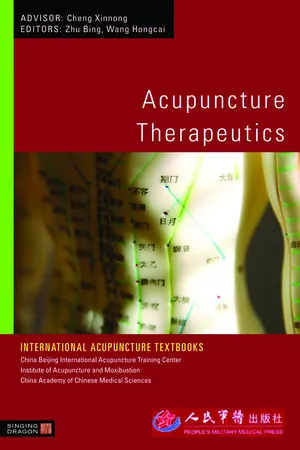![]()
CHAPTER GENERAL INTRODUCTION | 1 |
![]()
I. FUNCTIONS OF ACUPUNCTURE
1. TO UNBLOCK THE MERIDIANS AND COLLATERALS
Acupuncture is a therapy in which points are stimulated by needles or moxibustion in order to activate circulation, regulate Qi and Blood to remove pathogenic factors and treat diseases, on the basis that meridians, collaterals and the Zang Fu organs are physiologically related and pathologically influenced. So, unblocking the meridians and collaterals is the main and most direct effect of acupuncture in the treatment of disease. Obstruction in the meridians and collaterals can be removed and circulation activated through the use of the appropriate acupuncture manipulation techniques.
Meridians and collaterals are pathways through which Qi and Blood circulate and where the exterior of the body connects with the interior. They are closely related to the Zang Fu organs. When a disease occurs, the meridians and collaterals can be affected first, and then Zang Fu organs involved, or vice versa. Acupuncture can promote Qi and Blood circulation, remove pathogenic factors, regulate Qi activities, adjust the functions of the Zang Fu organs, and treat both deficient and excess syndromes of Qi and Blood in the meridians and collaterals.
2. TO STRENGTHEN BODY RESISTANCE AND ELIMINATE PATHOGENIC FACTORS
Strengthening body resistance and eliminating pathogenic factors are fundamental principles underlying the use of acupuncture in the treatment of disease. To strengthen the body resistance is to reinforce the anti-pathogenic Qi, and enhance the body’s resistance.
Once the anti-pathogenic Qi is strengthened, pathogenic factors will be eliminated. To eliminate pathogenic factors is to remove the causative factors of disease. When the pathogenic factors are removed, the injury to the anti-pathogenic Qi can be alleviated. The course of a disease, including its occurrence, development and transmission, is actually the process of the conflict between the anti-pathogenic Qi and pathogenic factors. When anti-pathogenic Qi defeats pathogenic Qi, pathogenic factors are removed, and a disease is cured; when anti-pathogenic Qi fails to fight against the pathogenic Qi, a disease becomes worse. So the function of acupuncture in the treatment of disease is one of engagement in the conflict between anti-pathogenic Qi and pathogenic Qi. The effect of acupuncture in strengthening the anti-pathogenic Qi and eliminating pathogenic factors is achieved by different needling techniques and combinations of acupoints:
1.Methods of treatment: Moxibustion has the function of strengthening the anti-pathogenic Qi; while Blood-letting puncturing therapy is effective in removing the pathogenic factors.
2.Acupuncture techniques: Reinforcing and reducing techniques of acupuncture are applied in order to strengthen the anti-pathogenic Qi and eliminate pathogenic factors respectively.
3.Points with reinforcing and reducing effects: Gaohuang (BL43), Qihai (CV6), Guanyuan (CV4), Mingmen (GV4), etc. are often used to strengthen the anti-pathogenic Qi; the twelve Jing-Well points, Shixuan (EX-UE11), Renzhong (GV26), etc. are frequently selected to eliminate the pathogenic Qi.
4.Order of treatment: The order in which to strengthen the anti-pathogenic Qi and eliminate pathogenic Qi depends on the conditions of increasing, decreasing and transformation of anti-pathogenic Qi and pathogenic Qi, whether the condition is the primary and secondary, and whether the syndrome is acute or chronic. In treating a disease, either the pathogenic factors can be eliminated first, and then anti-pathogenic Qi strengthened; or anti-pathogenic Qi strengthened first, then pathogenic Qi removed; or, alternatively, anti-pathogenic Qi can be strengthened and pathogenic Qi eliminated simultaneously. Generally speaking, there is a principle ‘to strengthen the anti-pathogenic Qi but leave no pathogenic Qi; to eliminate pathogenic Qi but not to hurt anti-pathogenic Qi’.
3. TO REGULATE YIN AND YANG
The key purpose of acupuncture in treating diseases is to regulate the excess and deficiency conditions of Yin and Yang, keep the body in a state of ‘balance of Yin and Yang’, and restore the normal physiological functions for the recovery of health. The occurrence of a disease results from a relative imbalance of Yin and Yang, namely excess and deficiency of Yin and Yang, leading to pathological changes such as ‘a Yang syndrome due to Yin excess, or Yin syndrome due to excess of Yang’. The regulation of Yin and Yang by acupuncture is fulfilled through the reinforcing and reducing needling techniques and combination of acupuncture points. For instance, in treating chronic diarrhoea caused by Spleen Yang deficiency, Yinlingquan (SP9) is punctured with the reinforcing technique combined with moxibustion based on the principle of warming Yang and dispelling Cold. In treating toothache due to excessive Stomach Fire in which Yang Heat is excessive, Neiting (ST44) is punctured with the reducing technique. During regulation of Yin and Yang, Front-Mu and Back-Shu points are often used clinically to regulate and replenish Yin and Yang of the Zang Fu organs according to the principle ‘to gain Yang from Yin, and gain Yin from Yang’.
II. PRINCIPLES OF TREATMENT
1. TO CLEAR HEAT AND DISPEL COLD
Cold syndromes: Syndromes caused by pathogenic Cold or Yang deficiency.
Heat syndromes: Syndromes caused by pathogenic Heat or Yin deficiency in the interior.
These two types of syndromes can be treated by applying the principle ‘short retention of the needles for Heat syndromes and longer retention of needles for Cold syndromes’.
1.1 Short retention of the needles for Heat syndromes
To clear Heat: The clearing method is used in acupuncture to treat Heat syndromes by dispelling and reducing Heat; namely, Heat is treated by Cold.
Application
1.Shallow insertion with quick removal of the needle, or pricking to cause bleeding with gentle and quick needling techniques, with short retention or without retention of the needles to clear Heat through use of reducing acupuncture techniques.
2.Apply three-edged needle, cutaneous needle, or filiform needles to cause bleeding to clear Heat.
3.Select Ying-Spring points to clear Heat. For example, Laogong (PC8) is punctured to clear Heart Fire. Bleeding at Dazhui (GV14), Quchi (LI11), and twelve Jing-Well points can clear Heat.
4.When pathogenic Heat moves into the interior, needling techniques of deep insertion with retention of the needles combined with a comprehensive ‘Penetrating-heaven coolness’ method should be applied.
1.2 Longer retention of needles for Cold syndromes
To warm Cold: The warming method is used in acupuncture to treat Cold syndromes by warming up Yang Qi and dispelling Cold, and to restore Yang from collapse; namely, Cold is treated by warmth.
Application
1.Deep insertion with longer retention of the needles, or combined with moxibustion to warm the meridians and dispel Cold.
2.Dispel Cold by applying moxibustion, cupping, and Fire needling therapies.
3.Apply moxibustion at Mingmen (GV4), Guanyuan (CV4).
4.For retention of Cold in the interior Zang Fu organs, deep insertion with longer retention of the needles should be applied combined with a comprehensive ‘Setting the mountain on Fire’ method or warming needle therapy. When there is Cold in the Blood, moxibustion will be effective for warming up the Blood vessels. But for a complicated syndrome of Cold and Heat, both clearing and warming methods should be applied at the same time.
2. TO REINFORCE DEFICIENCY AND REDUCE EXCESS
Deficiency syndromes: Syndromes in which the anti-pathogenic Qi is deficient.
Excess syndromes: Syndromes in which pathogenic Qi is excessive.
For deficiency and excess syndromes, the principles of acupuncture treatment are ‘reinforcing deficiency and reducing excess’. For a condition that involves neither a deficiency nor an excess syndrome, points of the affected meridians are selected.
2.1 To reinforce deficiency
Reinforcing deficiency means strengthening the anti-pathogenic Qi, promoting the functions of the Zang Fu organs and tissues, replenishing Yin, Yang, Qi and Blood of the body to improve the body resistance against diseases.
Application
Acupuncture using reinforcing needling techniques or moxibustion, which pertains to the reinforcing method, can be used to treat deficiency syndromes. Yang and Qi deficiency syndromes can be treated by the acupuncture reinforcing method combined with moxibustion. Qihai (CV6) is punctured for Qi deficiency, Mingmen (GV4) for Yang deficiency. For Yin or Blood deficiency syndromes, either acupuncture reinforcing or uniform reinforcing and the reducing methods can be applied. Moxibustion is applicable for Blood deficiency. When Yin and Yang are both deficient, Guanyuan (CV4), Qihai (CV6), Mingmen (GV4), Zusanli (ST36), Back-Shu points of the related organs, and the Yuan-Primary points can be punctured with the reinforcing technique, or moxibusti...

